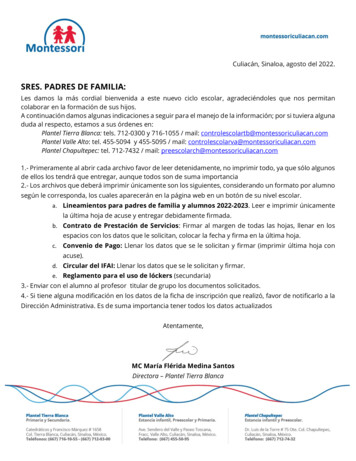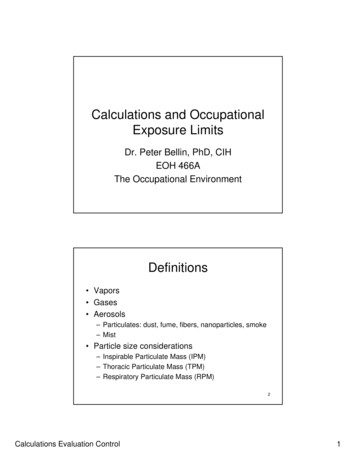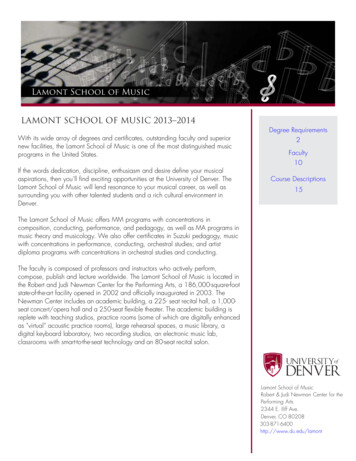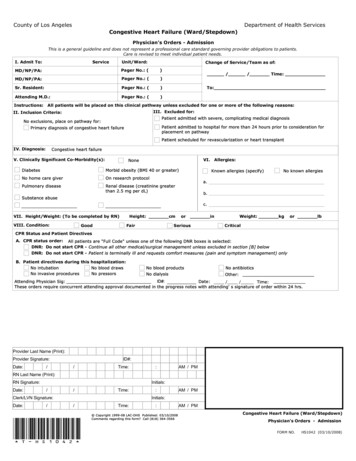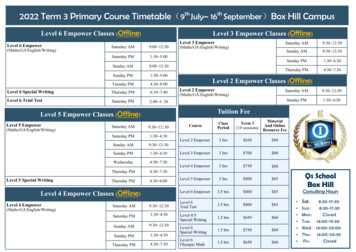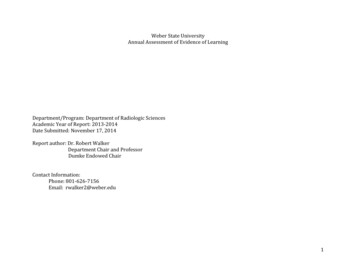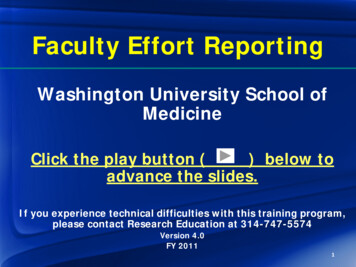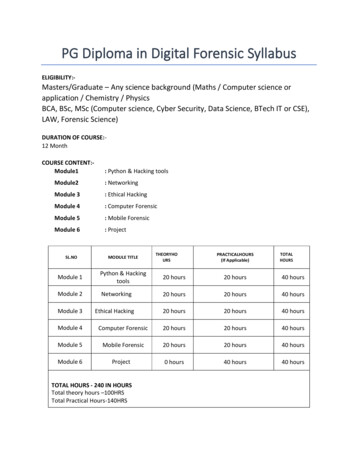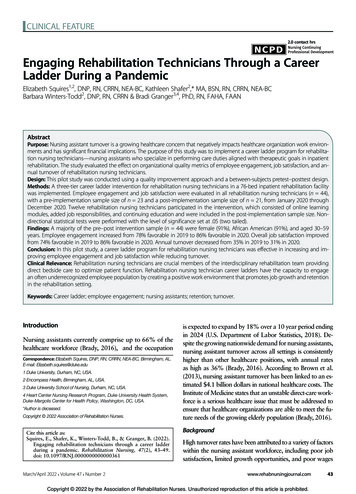
Transcription
CLINICAL FEATURE2.0 contact hrsEngaging Rehabilitation Technicians Through a CareerLadder During a PandemicElizabeth Squires1,2, DNP, RN, CRRN, NEA-BC, Kathleen Shafer2,* MA, BSN, RN, CRRN, NEA-BCBarbara Winters-Todd2, DNP, RN, CRRN & Bradi Granger3,4, PhD, RN, FAHA, FAANAbstractPurpose: Nursing assistant turnover is a growing healthcare concern that negatively impacts healthcare organization work environments and has significant financial implications. The purpose of this study was to implement a career ladder program for rehabilitation nursing technicians—nursing assistants who specialize in performing care duties aligned with therapeutic goals in inpatientrehabilitation. The study evaluated the effect on organizational quality metrics of employee engagement, job satisfaction, and annual turnover of rehabilitation nursing technicians.Design: This pilot study was conducted using a quality improvement approach and a between-subjects pretest–posttest design.Methods: A three-tier career ladder intervention for rehabilitation nursing technicians in a 76-bed inpatient rehabilitation facilitywas implemented. Employee engagement and job satisfaction were evaluated in all rehabilitation nursing technicians (n 44),with a pre-implementation sample size of n 23 and a post-implementation sample size of n 21, from January 2020 throughDecember 2020. Twelve rehabilitation nursing technicians participated in the intervention, which consisted of online learningmodules, added job responsibilities, and continuing education and were included in the post-implementation sample size. Nondirectional statistical tests were performed with the level of significance set at .05 (two tailed).Findings: A majority of the pre–post intervention sample (n 44) were female (91%), African American (91%), and aged 30–59years. Employee engagement increased from 78% favorable in 2019 to 86% favorable in 2020. Overall job satisfaction improvedfrom 74% favorable in 2019 to 86% favorable in 2020. Annual turnover decreased from 35% in 2019 to 31% in 2020.Conclusion: In this pilot study, a career ladder program for rehabilitation nursing technicians was effective in increasing and improving employee engagement and job satisfaction while reducing turnover.Clinical Relevance: Rehabilitation nursing technicians are crucial members of the interdisciplinary rehabilitation team providingdirect bedside care to optimize patient function. Rehabilitation nursing technician career ladders have the capacity to engagean often underrecognized employee population by creating a positive work environment that promotes job growth and retentionin the rehabilitation setting.Keywords: Career ladder; employee engagement; nursing assistants; retention; turnover.IntroductionNursing assistants currently comprise up to 66% of thehealthcare workforce (Brady, 2016), and the occupationCorrespondence: Elizabeth Squires, DNP, RN, CRRN, NEA-BC, Birmingham, AL.E-mail: Elizabeth.squires@duke.edu1 Duke University, Durham, NC, USA.2 Encompass Health, Birmingham, AL, USA.3 Duke University School of Nursing, Durham, NC, USA.4 Heart Center Nursing Research Program, Duke University Health System,Duke-Margolis Center for Health Policy, Washington, DC, USA.*Author is deceased.Copyright 2022 Association of Rehabilitation Nurses.Cite this article as:Squires, E., Shafer, K., Winters-Todd, B., & Granger, B. (2022).Engaging rehabilitation technicians through a career ladderduring a pandemic. Rehabilitation Nursing, 47(2), 43–49.doi: 10.1097/RNJ.0000000000000361March/April 2022 Volume 47 Number 2is expected to expand by 18% over a 10 year period endingin 2024 (U.S. Department of Labor Statistics, 2018). Despite the growing nationwide demand for nursing assistants,nursing assistant turnover across all settings is consistentlyhigher than other healthcare positions, with annual ratesas high as 36% (Brady, 2016). According to Brown et al.(2013), nursing assistant turnover has been linked to an estimated 4.1 billion dollars in national healthcare costs. TheInstitute of Medicine states that an unstable direct-care workforce is a serious healthcare issue that must be addressed toensure that healthcare organizations are able to meet the future needs of the growing elderly population (Brady, 2016).BackgroundHigh turnover rates have been attributed to a variety of factorswithin the nursing assistant workforce, including poor jobsatisfaction, limited growth opportunities, and poor wageswww.rehabnursingjournal.comCopyright 2022 by the Association of Rehabilitation Nurses. Unauthorized reproduction of this article is prohibited.43
44Engaging Rehabilitation Nursing Technicians(Brown et al., 2013; Lerner et al., 2011). Nursing assistantsare typically the least compensated healthcare professionals,with a national average salary of 28,500 per year (Gion &Abitz, 2019). Nursing assistants provide 80% of direct patient care, performing duties such as feeding, bathing, toileting,dressing, grooming, transferring, vital signs, and changinglinens (Walton & Rogers, 2017). Nursing assistants are a vitalcomponent of the interdisciplinary team and desire adequatecompensation for their work and advancement potential(Brown et al., 2013). Healthcare leaders must seek to developstrategies to empower nursing assistants while improving jobsatisfaction and wages in this employee population to stabilize the nursing assistant workforce (Berridge et al., 2018).Advanced training programs have been found to enhancejob satisfaction in the nursing assistant population (Lerneret al., 2011). Although nursing assistants spend the majorityof their time performing direct patient care, they have theleast amount of education and training (Gion & Abitz,2019). A longitudinal cohort study by Brown et al. (2013)demonstrated that an educational program, consisting ofanatomy and physiology, infection control, and skills laboratories, for nursing assistants reduced turnover, improved jobsatisfaction, and decreased patient falls. Remsburg et al.(2001) developed a career ladder composed of advancedtraining in various clinical skills, including phlebotomy, electrocardiograms, and catheter insertion, leading to increasedretention rates during the first 2 years following the training.Staff recognition is an important component of nursing assistant career ladders (Gion & Abitz, 2019; Lerneret al., 2011; Parsons et al., 2003). Parsons et al. (2003)surveyed 550 nursing assistants and found they were mostdissatisfied with appreciation and recognition. Accordingto Lerner et al. (2011), nursing assistants’ perception of being valued by nurses and nurse leaders is a vital componentof overall job satisfaction. Although career ladder programsmay vary among institutions, their main objective is increasing job satisfaction (Bitanga & Austria, 2013; Garcia et al.,2003). Senecal et al. (2020) found that job satisfaction andintent to stay were threatened by the lack of advancementopportunities. Rehabilitation nursing technicians, nursingassistants who specialize in performing care duties alignedwith therapeutic goals, are crucial members of the interdisciplinary team in inpatient rehabilitation. Rehabilitationnursing technicians support an environment that focuseson patient safety and patient-centered treatment.RationaleIn our local clinical setting, a 76-bed acute inpatient rehabilitation hospital, rehabilitation nursing technicians comprised40% of the nursing department’s workforce. Rehabilitationnursing technician turnover in 2019 was 35%. The employeeE. Squires et al.engagement index for rehabilitation nursing technicians, asindicated on the annual employee engagement survey, was78% favorable in 2019. Job satisfaction for rehabilitationnursing technicians, as indicated on the annual employeeengagement survey, was 74% favorable. Specific items ofopportunity were related to employee development, communication, and intent to stay. Mediocre engagement andhigh turnover rates make this employee population a targetfor innovation and intervention.Evidence in the literature supports the development of arehabilitation nursing technician career ladder for inpatientrehabilitation. Existing studies show that nursing assistantcareer ladders that include education and training addedjob responsibilities and those that incorporate employeerecognition effectively improved job satisfaction and reducedturnover (Maier, 2002; Remsburg et al., 2001). Research demonstrated that when designed and implemented effectively,clinical ladder programs yield positive outcomes for patients,staff, and healthcare organizations (Moore et al., 2019).Specific AimsThe purpose of this pilot study was to implement a careerladder for rehabilitation nursing technicians. The first aimof the rehabilitation nursing technician career ladder wasto increase employee engagement by 5% over 1 year. Employee engagement was measured using an engagementindex, a standard measure that includes pride, referral behavior, intent to stay, intrinsic motivation, and overall satisfaction. The annual employee engagement survey was chosenby the corporation that owns the rehabilitation hospital asa validated tool available through Perceptyx. The tool targetsthe population of interest and addresses major concerns foremployee satisfaction. The study team, including the chiefnursing officer, nurse manager, and nurse educator, usedthe tool because it was available for all employees and wasa method to study the outcome of the rehabilitation nursing technician career ladder. It enabled tracking of blindedemployee engagement data across time. Employees arestrongly encouraged to participate in the survey to providefeedback to hospital leadership. Hospital leadership aggregate results to guide improvement and positive change.Other aims included improving overall job satisfactionfor rehabilitation nursing technicians on the employee engagement survey by 5% over 1 year and reducing annualized rehabilitation nursing technician turnover by 10%.MethodsContextThe rehabilitation nursing technician career ladder programwas implemented in a 76-bed acute inpatient rehabilitationCopyright 2022 by the Association of Rehabilitation Nurses. Unauthorized reproduction of this article is prohibited.
www.rehabnursingjournal.comMarch/April 2022 Volume 47 Number 2hospital in the southeast United States. The study was reviewed by the local institutional review board and deemedto be exempt as it is a quality improvement project notmeeting the definition of human subjects research. All employees at the rehabilitation hospital were invited and encouraged to participate in the annual engagement survey, althoughparticipation was not required. Qualifications to participatein the career ladder included uninterrupted full-time statusof 6 months or longer; 2019 annual performance evaluationlevel of strong, very strong, or excellent; and absence of disciplinary action within the past year. Exclusion criteria werefull-time status of less than 6 months, 2019 annual performance evaluation of moderate or weak, and disciplinaryaction within the previous year. Based on eligibility requirements, 12 out of 21 rehabilitation nursing technicians wereinvited and agreed to participate in the first cohort of theevaluation of the career ladder program.MeasuresThe annual employee engagement survey took place 5 monthsafter the rehabilitation nursing technicians joined the cohort (Figure 1). The computerized third-party survey wasopen for 1 month, and staff were able to complete the survey at their own convenience. Hospital leadership was45able to access the results of the survey electronically approximately 1 month after the survey closed. The engagement survey was deemed a highly reliable tool, with theemployee engagement index yielding a Cronbach’s alphaof .921 and the overall job satisfaction item yielding aCronbach’s alpha of .865.InterventionsThe chief nursing officer, the nurse manager, and the nurseeducator implemented the three-tier nursing assistant career ladder, consisting of three core components: onlinelearning modules, added job responsibilities, and onlinecontinuing education. This pilot study focused on rehabilitation nursing technicians who qualified to enter thecareer ladder and could advance from Rehabilitation Nursing Technician (RNT) to Rehabilitation Nursing Technician1 (RNT1; Figure 1).The hospital educator, a certified registered rehabilitation nurse with over 14 years of experience in the rehabsetting, wrote the content of the career ladder course withcontributions from the interdisciplinary team. A 40-questionmultiple-choice pretest was written at a fifth-grade reading level to assess baseline knowledge. The 2-day (16-hour)career ladder course included a variety of topics selectedFigure 1. Rehabilitation nursing technician career ladder structure.Copyright 2022 by the Association of Rehabilitation Nurses. Unauthorized reproduction of this article is prohibited.
46Engaging Rehabilitation Nursing Techniciansto enhance the knowledge and skill set of rehabilitationnursing technicians (Table 1). An identical 40-questionmultiple-choice posttest was to be administered followingthe course, with a passing score of 90% required to advanceon the ladder.Several modifications to the original intervention tookplace. The 2-day career ladder course scheduled in Mayof 2020 did not occur because of social distancing andstaffing constraints related to the onset of the COVID-19pandemic. Instead, the content was converted to self-pacedonline learning modules. In addition, the corporation thatowned the rehabilitation hospital finalized a nursing assistant career ladder in May of 2020 to streamline programsacross all of the company’s rehabilitation hospitals. Thehospital continued with the original career ladder, with aslight variation in rehabilitation nursing technician job titles.RNT1 became the job title for entry-level RNTs. Therefore,the RNTs’ job titles automatically changed to RNT1, andthey were promoted to RNT2 upon ladder advancement(Figure 1), with the potential to advance to RNT3 andRNT4 in future cohorts.Career ladder participants had initial meetings withthe nurse manager to discuss assignments of additionalduties on the nursing unit. Potential additional duties included being a new hire preceptor or bath, mobility, patient experience, fall, skin care, documentation, and handhygiene champions. Monthly meetings took place betweenthe rehabilitation nursing technicians and the nurse manager and/or direct supervisor to ensure responsibilities werebeing met. Rehabilitation nursing technicians were givena 5% raise with advancement on the ladder. The promotional raises occurred in June of 2020 and did not replacethe employees’ annual merit increases scheduled for Octoberof 2020. Rehabilitation nursing technicians qualify to advance a tier on the ladder annually if job requirementsand responsibilities are met.Study of the InterventionsThe project used a between-subjects pre–post test design withtwo independent groups to evaluate employee engagementTable 1 Career Ladder Educational OfferingsIllnessesJob PerformanceStrokeTraumatic brain injurySpinal cord injuryTotal joint replacementAmputationParkinson's diseaseAlzheimer's diseaseDementiaDiabetesPurposeful roundingReportable symptomsFall precautionsOral care and prevention of aspirationExternal defibrillatorBladder scanningDysphagiaInfection controlDeath and dyingE. Squires et al.and job satisfaction. Participants in the pre and post groupsreflected all rehabilitation nursing technicians (n 44).The pre-intervention group consisted of all rehabilitationnursing technicians who participated in the 2019 employee engagement survey (n 23). The post-interventiongroup consisted of all rehabilitation nursing technicianswho participated in the 2020 employee engagement survey (n 21) and included the 12 rehabilitation nursingtechnicians who elected to participate in the career laddercomponent of the intervention.Blinded Likert scale data were extracted for each rehabilitation nursing technician who participated in thesurvey for the engagement category. The Likert scale datawere grouped into two categories (0, 1). Scores 1, 2, and 3were coded as unfavorable (0), and scores 4 and 5 werecoded as favorable (1).Data AnalysisDescriptive analysis from the engagement survey datawas used to characterize participants’ demographics, including age, gender, length of service, and shift worked.A chi-square test was used to evaluate employee engagement in rehabilitation nursing technicians pre- and postimplementation of the career ladder (Aim 1) and jobsatisfaction of rehabilitation nursing technicians pre- andpost-implementation of the career ladder (Aim 2). Descriptive statistics (counts, means, and standard deviations) anda statistical control chart were used to evaluate annualizedrehabilitation nursing technician turnover, and total lossturnover was tracked monthly from January 2020 throughDecember 2020. Nondirectional statistical tests were performed with the level of significance set at .05 (two tailed).All analyses were conducted using SPSS Version 23.ResultsThe results reflected improvement in the three outcomemeasures post-intervention based on the interventions andassociated measures (Table 2). The first aim was to increasethe employee engagement index for rehabilitation nursingtechnicians on the employee engagement survey by 5% over1 year; this aim was met as the score increased by 8%. Thequestions that comprised the engagement index included thefollowing: My work gives me a feeling of personal accomplishment (decreased by 1%); I am proud to work for thiscompany/hospital (increased by 8%); I intend to stay withthis company/hospital for 12 months (increased by 7%);Overall, I am satisfied with my job (increased by 12%); Thiscompany/hospital is a great place to work (increased 12%).The second aim was to increase overall job satisfaction by 5%; this aim was met as the score increased by12%. The last aim was to reduce rehabilitation nursingCopyright 2022 by the Association of Rehabilitation Nurses. Unauthorized reproduction of this article is prohibited.
www.rehabnursingjournal.comMarch/April 2022 Volume 47 Number 247Table 2 Engagement Survey Results Pre- and Post-InterventionItem% Favorable 2019 (n)n 23% Favorable 2020 (n)n 21% Increasep78 (18)87 (20)78 (17)74 (17)74 (18)74 (17)86 (18)86 (18)86 (18)81 (17)81 (18)86 (18)8 187712.701.701.7241.0.701.462Engagement indexMy work gives me a feeling of personal accomplishmentI am proud to work for this company/hospitalI intend to stay with this company/hospital 12 monthsThis company/hospital is a great place to workOverall job satisfactiontechnician turnover by 10%; this goal was not met as theturnover rate decreased by 4%.Although raw scores were improved, the differenceswere not statistically significant (Table 2). A chi-squaretest of independence was performed to examine the engagement index pre- and post-implementation of the careerladder, χ2(1, N 44) 0.410, p .701. A chi-square testof independence was performed to examine job satisfaction pre- and post-implementation of the career ladder,χ2(1, N 44) 0.940, p .462. A Mann–Whitney testindicated the 2020 turnover (M 0) was not statistically different from the 2019 turnover rate (M 0), U 70.000,p .894 (Figure 2).DiscussionThe rehabilitation nursing technician career ladder positively impacted engagement and job satisfaction and decreased annual turnover by 4% during an unprecedentedyear for healthcare providers because of the COVID-19pandemic. The improved engagement scores, reductionin turnover overall, and continued interest in the ladderare generalizable observations that we can attribute directlyto the career ladder program, despite inability to demonstratestatistical significance because of the small sample size.Importantly, the findings underscore the importance ofan organizational commitment to the role of the rehabilitation nursing technician and the value of demonstratingthis commitment in a financially tangible way. Senecalet al. (2020) acknowledged low compensation as a barrierto staff retention and identified intrinsic fulfillment including competence, self-confidence, and recognition as meansto mitigate turnover. The career ladder program was ableto address both compensation and the intrinsic needs of rehabilitation nursing technicians.A unique aspect of this study was the target population,rehabilitation nursing technicians. This role is traditionallyan unstable component of the overall employee population(Trinkoff et al., 2013). COVID-19 and the fear of remainingin the workplace affected several of the rehabilitation nursing technicians and contributed to unrest. The generalizability in this case was limited due to these external factors. In spite of these factors, direct anecdotal feedbackwas received from the rehabilitation nursing techniciansregarding the extent to which they valued the intervention, the overall program, and the effort made to improvetheir job satisfaction.Among the few studies evaluating the impact of careerladders on nursing assistants (Maier, 2002; Remsburg et al.,2001), the studies are similar in that they improved job satisfaction and increased retention rates. Although our findings were similar to earlier studies, the timing of this studyFigure 2. Rehabilitation nursing technician turnover rates.Copyright 2022 by the Association of Rehabilitation Nurses. Unauthorized reproduction of this article is prohibited.
48Engaging Rehabilitation Nursing Technicianswas unique. The COVID-19 pandemic had a negative impact on frontline staff, with early studies demonstrating highlevels of depression, anxiety, insomnia, and distress amongthis employee population (Berkow et al., 2020). Rehabilitation nursing technicians are at particular risk of thesesymptoms because they spend the majority of their timeperforming direct patient care. The project was implemented during a difficult time at the hospital, when morale was strained because of the stress and uncertainty ofthe pandemic.Several rehabilitation nursing technicians voiced appreciation that the hospital had developed a program justfor them. Rehabilitation nursing technicians demonstratedpride and excitement at the ability to advance in the careerladder. In addition, the ladder impacted not just those whoparticipated but the entire employee group. Several rehabilitation nursing technicians who were ineligible to advance on the ladder showed interest in participating inthe next cohort scheduled to begin in May of 2021.Although rehabilitation nursing technician turnoverdecreased in this study, it remained below the project goalof 10%, which had been established as a target for workforce stability. The impact of the pandemic must be considered as fear, psychological distress, and burnout affectedfrontline staff and contributed to turnover risk (Labrague &de los Santos, 2020; Travers et al., 2020; White et al., 2021).Although the reduction in turnover was small, any turnoverreduction could be considered a win.The direct costs of the ladder minimally increased thesalaries and wages of the hospital. The cost–benefit ofretaining experienced rehabilitation nursing techniciansfar exceeded the potential cost of hiring and trainingnew rehabilitation nursing technicians, although a fullcost analysis was not conducted as part of this study.Although 192 education hours (12 participants with16 hours total) were budgeted for the 2-day classroomlearning, that cost was eliminated with the transition toself-study learning modules.LimitationsThis study had several limitations. The COVID-19 pandemicsignificantly threatens the internal and external validity ofthe study. It is difficult to state whether the interventionwould yield similar results in other settings, situations, orenvironments because of the unprecedented circumstances.Healthcare workers were subjected to tremendous strain,as they struggled to deal with rapidly evolving guidancefrom the Centers for Disease Control and Prevention, personal protective equipment shortages, and staff exposuresand illnesses. One must consider that had the study takenplace during a different time period, results may have beenE. Squires et al.different. Finally, the small sample size was a threat to the internal validity of the study. Evaluation of the interventionon a broader scale across multiple facilities would yieldstronger results.ConclusionRehabilitation nursing technicians are crucial membersof the interdisciplinary team, spending the majority oftheir time in direct bedside care. However, they often feelundervalued, underpaid, and underrecognized by othermembers of the interdisciplinary team and administration, which contributes to high turnover rates. Previousstudies have found career ladders to be a potential approach for mitigating these challenges, as they have beenshown to improve employee engagement and job satisfaction while reducing turnover. In our study evaluatingcareer ladder application to practice, we found career ladders to be sustainable, feasible, of minimal impact on laboror costs, and of benefit to the job performance of currentemployees. Although the career ladder in the study was developed specifically for rehabilitation nursing techniciansin the rehabilitation setting, the framework could easilybe adjusted to meet the needs of alternate healthcare settings. Further research in this area is warranted with alarger sample size.Conflict of InterestAll authors declare no conflict of interest.FundingNo external funding was obtained for this study.ReferencesBerkow, S., Virkstis, K., Herleth, A., Whitemarsh, K., & Rewers, L.(2020). An executive strategy to support long-term clinicianengagement amid the COVID-19 pandemic. Journal of NursingAdministration, 50(12), 616–617. 10.1097/NNA.0000000000000946Berridge, C., Tyler, D. A., & Miller, S. C. (2018). Staff empowermentpractices and CNA retention: Findings from a nationally representativenursing home culture change survey. Journal of Applied Gerontology,37(4), 419–434. 10.1177/0733464816665204Bitanga, M. E., & Austria, M. (2013). Climbing the clinical ladder—One rung at a time. Nursing Management (Springhouse), 44(5),23–27. 10.1097/01.NUMA.0000429008.93011.a3Brady, D. M. (2016). An exploration of nursing assistants’ perceptionsabout job satisfaction. Critical Care Nursing, 39(4), 371–386.Brown, M., Redfern, R. E., Bressler, K., Swicegood, T. M., & Molnar,M. M. (2013). Effects of an advanced nursing assistant educationprogram on job satisfaction, turnover rate, assistant educationprogram on and clinical outcomes. Journal of GerontologicalNursing, 39(10), 34–43. 10.3928/00989134-20130612-02Garcia, R. M., Sublett, C., Pettee, E. J., & Knox, J. (2003). Thenursing assistant to licensed practical nurse program. Journalfor Nurses in Staff Development, 19(5), 231–234.Copyright 2022 by the Association of Rehabilitation Nurses. Unauthorized reproduction of this article is prohibited.
March/April 2022 Volume 47 Number 2Gion, T., & Abitz, T. (2019). An approach to recruitment and retentionof certified nursing assistants using innovation and collaboration.The Journal of Nursing Administration, 49(7/8), 354–358.Labrague, L. J., & de los Santos, J. A. A. (2020). Fear of COVID-19,psychological distress, work satisfaction and turnover intentionamong frontline nurses. Journal of Nursing Management, 29(3),395–403. 10.1111/jonm.13168Lerner, N., Resnick, B., Galik, E., & Flynn, L. (2011). Job satisfactionof nursing assistants. The Journal of Nursing Administration,41(11), 473–478.Maier, G. (2002). Career ladders: An important element in CNAretention. Certificate nursing assistant. Geriatric Nursing Management,23, 217–219. 10.1067/mgn.2002.126971Moore, A., Meucci, J., & Mcgrath, J. (2019). Attributes of an effectivecareer ladder program for nurses: An integrative review. Worldviewson Evidence Based Nursing, 16, 263–270. Retrieved from https://doi.org/10.1111/wvn.12371Parsons, S. K., Simmons, W. P., Penn, K., & Furlough, M. (2003).Determinants of satisfaction and turnover among nursing assistants:The results of a statewide survey. Journal of GerontologicalNursing, 29(3), 51–58.Remsburg, R. E., Richards, M., Myers, S., Shoemaker, D., Radu, C.,Doane, L., & Green, K. (2001). Creating a career ladder for nursingassistants in long-term care. Geriatric Nursing Management, 22(6),318–325. Senecal, M. B., Mcbride, K., Steiner, V., Pierce, L., & Saltzman, B.(2020). State tested nursing assistants’ workplace experiencesthat threaten or support intent to stay. Rehabilitation Nursing,45, 323–331. 10.1097/rnj.0000000000000232Travers, J. L., Schroeder, K., Norful, A. A., & Aliyu, S. (2020). Theinfluence of empowered work environments on the psychologicalexperiences of nursing assistants during COVID-19: A qualitativestudy. BMC Nursing, 19, 98. 10.1186/s12912-020-00489-9Trinkoff, A. M., Han, K., Storr, C. L., Lerner, N., Johantgen, M., &Gartrell, K. (2013). Turnover, staffing, skill mix, and resident outcomesin a national sample of U.S. nursing homes. Journal of NursingAdministration, 43, 630–636. 10.1097/NNA.0000000000000004U.S. Department of Labor Statistics. (2018). Nursing assistants andorderlies. Occupational Outlook, U.S. Department of Labor,September 17, 2018. https: tab-6Walton, A. L., & Rogers, B. (2017). Workplace hazards faced bynursing assistants in the United States: A focused literaturereview. International Journal of Environmental Research andPublic Health, 14(5), 544. 10.3390/ijerph14050544White, E. M., Wetle, T. F., Reddy, A., & Baier, R. R. (2021). Frontline nursing home staff experiences during the COVID-19 pandemic.Journal of the American Medical Directors Association, 22(1),199–203. 10.1016/j.jamda.2020.11.022For more than 19
Engaging Rehabilitation Technicians Through a Career Ladder During a Pandemic Elizabeth Squires1,2, DNP, RN, CRRN, NEA-BC, Kathleen Shafer2,* MA, BSN, RN, CRRN, NEA-BC Barbara Winters-Todd2, DNP, RN, CRRN & Bradi Granger3,4, PhD, RN, FAHA, FAAN Abstract Purpose: Nursing assistant turnover is a growing he althcare concern that negatively impacts healthcare organization work environ-
